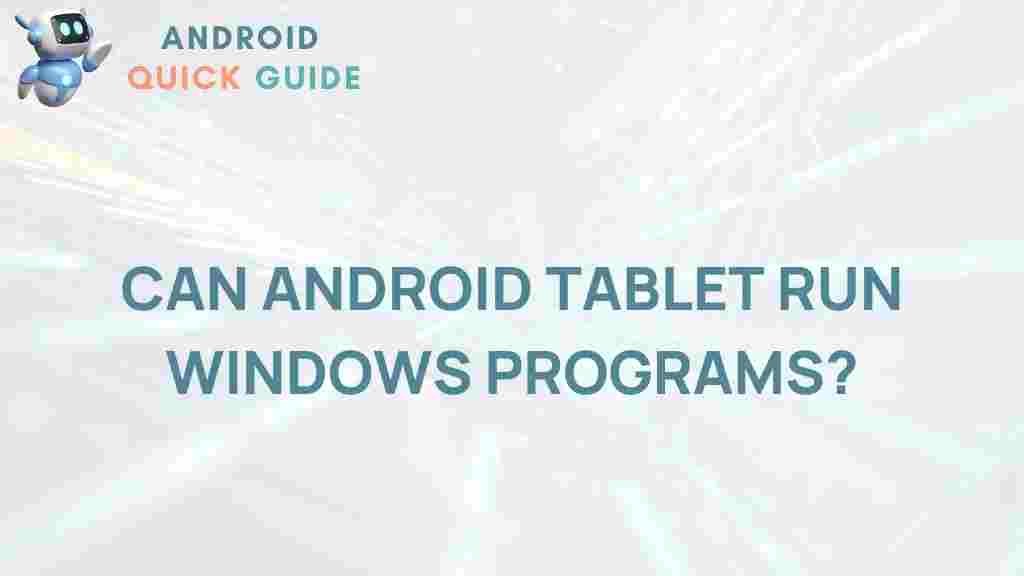Unveiling the Mystery: Can Android Tablets Run Windows Programs?
In today’s tech-savvy world, the boundaries between operating systems are becoming increasingly blurred. Users often wonder about the capabilities of their devices, particularly when it comes to Android tablets. With the rise of mobile computing, many seek to understand if their Android tablets can run Windows programs. This article will explore the feasibility of this idea, the methods available to achieve it, and offer troubleshooting tips to enhance your experience.
Understanding the Android Ecosystem
Android is a versatile operating system primarily designed for mobile devices. It provides a user-friendly interface and supports a vast array of applications through the Google Play Store. However, its architecture is quite different from that of Windows, which is tailored for PCs and laptops. This fundamental difference raises the question: can Android effectively run Windows programs?
Can Android Tablets Run Windows Programs? An Overview
In short, running native Windows programs on an Android tablet is not straightforward due to the differences in operating systems. However, various methods can enable users to access Windows applications on their Android devices. Here are the most common approaches:
- Remote Desktop Applications: Using applications like Microsoft Remote Desktop or TeamViewer allows you to access your Windows PC from your Android tablet.
- Emulators: Software like Wine or CrossOver can create a Windows-like environment on your Android tablet, allowing some Windows applications to run.
- Virtual Machines: Apps like VNC Viewer can run a Windows virtual machine on your Android tablet, although this method can be resource-intensive.
The Step-by-Step Process of Running Windows Programs on Android
Method 1: Using Remote Desktop Applications
Remote desktop applications offer the easiest and most effective way to run Windows programs on Android tablets. Here’s how to set it up:
- Install Remote Desktop Software: Download and install Microsoft Remote Desktop on your Android tablet from the Google Play Store.
- Configure Your Windows PC: Enable Remote Desktop on your Windows PC by going to Settings > System > Remote Desktop and toggling the switch.
- Connect to Your PC: Open the Remote Desktop app on your Android device, input your PC’s IP address, and log in with your credentials.
This method provides a seamless experience, as you can run any Windows application directly from your tablet as if you were using your PC.
Method 2: Using Emulators
Emulators like Wine can mimic a Windows environment, allowing some Windows programs to run on your Android tablet. Follow these steps:
- Download Wine: Visit the Wine website and download the appropriate version for Android.
- Install Wine: Open the downloaded file and install Wine on your tablet.
- Run Windows Applications: Use Wine to navigate to the Windows application installer and run it. Note that compatibility varies, and not all programs may work flawlessly.
While this method may not support all Windows applications, it can be a viable solution for lightweight software.
Method 3: Using Virtual Machines
For users who need a full Windows experience, creating a virtual machine is an option, though it requires more resources:
- Choose a Virtual Machine Software: Apps like VNC Viewer or Parsec can help set up a virtual Windows environment.
- Install the Virtual Machine: Follow the instructions provided by the software to install a Windows OS on the virtual machine.
- Connect and Use: Access your virtual machine from your Android tablet and run Windows applications as needed.
This method offers the most comprehensive functionality but may be limited by your tablet’s hardware capabilities.
Troubleshooting Common Issues
Even with the best setups, users may encounter issues when trying to run Windows programs on their Android tablets. Here are some common problems and solutions:
- Slow Performance: If applications are running slowly, consider reducing the number of applications running simultaneously on your PC or upgrading your Android tablet’s hardware.
- Connection Issues: Ensure both your tablet and PC are connected to a stable internet connection. For remote desktop applications, check your firewall settings to allow connections.
- Compatibility Errors: Not all Windows applications will run smoothly on emulators. Check the compatibility lists provided by the emulator to find suitable software.
Conclusion: Bridging the Gap Between Android and Windows
While Android tablets are not designed to natively run Windows programs, various methods can facilitate this functionality. Whether you opt for remote desktop applications, emulators, or virtual machines, each has its own benefits and limitations. By understanding the capabilities of Android and leveraging available technologies, users can effectively bridge the gap between these two operating systems.
For more detailed guides and resources on using Android devices, visit our Android Resource Page. Additionally, for external insights and developments related to Android, check out Android Central.
With the right tools and knowledge, running Windows programs on your Android tablet is more than just a possibility—it’s an achievable reality.
This article is in the category Reviews and created by AndroidQuickGuide Team
